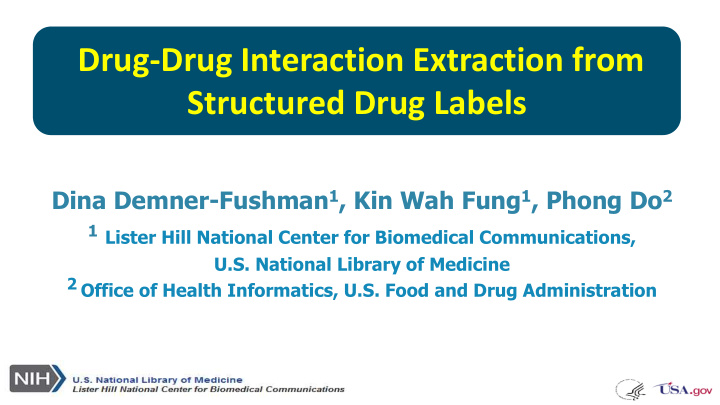



Drug-Drug Interaction Extraction from Structured Drug Labels Dina Demner-Fushman 1 , Kin Wah Fung 1 , Phong Do 2 1 Lister Hill National Center for Biomedical Communications, U.S. National Library of Medicine 2 Office of Health Informatics, U.S. Food and Drug Administration
Mechanisms of Drug-Drug Interaction http://www.sciencedirect.com/topics/pharmacology-toxicology-and-pharmaceutical-science/drug-interaction A drug interaction results when the effects of a drug are altered in some way by the • presence of another drug, by food, or by environmental exposure. The risk of developing an adverse drug reaction (ADR) secondary to a drug–drug interaction • increases significantly with the number of medications a patient is receiving. Mechanisms of drug interactions: • A pharmacodynamic interaction results when a drug interferes with a second drug at its • target site, or changes in some way its anticipated pharmacologic response. The consequence of this interaction results in additivity, synergy, or antagonism of the intended effect. An example of a pharmacodynamic interaction is the synergism that results from combining two or more anti-infectives in the treatment of a resistant pathogen. Pharmacokinetic interactions occur when one drug alters the absorption, distribution, • metabolism, or elimination of another drug, thereby changing its concentration in plasma and, consequently, at the targeted site of action. Clinically significant drug interactions are most often due to alterations in pharmacokinetics, secondary to modulation of drug metabolism .
Relevant SPL sections Boxed Warning, Contraindications, Dosage and Administration, Drug and/or laboratory test interaction, Drug Interactions, Precautions, Warnings and Precautions, Warnings
Related work • An attempt to combine all publically available PDDIs sources. • The merged dataset consists of fourteen different sources of PDDIs information. • Ayvaz S, Horn J, Hassanzadeh O, Zhu Q, Stan J, Tatonetti NP, Vilar S, Brochhausen M, Samwald M, Rastegar-Mojarad M, Dumontier M. Toward a complete dataset of drug– drug interaction information from publicly available sources. Journal of biomedical informatics. 2015 Jun 30;55:206-17.
Annotation • Entities I don't like You still have this label to annotate it • Drug • Drug class • Substance • Span / Expression • Interaction events • Caution ( Unspecified) • Increase / Decrease ( Pharmacokinetic) • Specific ( Pharmacodynamic)
Training set
Objective • Identify substances interacting with the label drug • Identify interaction type • Provide justification (sentence containing the interaction) • Produce output for FDA review: • Sentences from the designated SPL sections • Section name • The type of interaction – pharmacokinetic, pharmacodynamic or unspecified • The labeled drug and generic ingredient(s) identified by the SPL set id • The interacting substance encoded in UNII, or in NDF-RT NUI if it is a drug class • The consequence of the interaction encoded in SNOMED CT if it is a medical condition, or in National Cancer Institute Thesaurus codes if it is a pharmacokinetic effect
Tasks • Task 1 • Extract Interacting Drugs/Substances and the sentences that contain interactions. • Task 2 • Identify the interacting drugs and the specific interaction types: pharmacokinetic, pharmacodynamic or unspecified. • Task 3 • Normalize the interacting substance to UNII, and the drug classes to NDF-RT NUI. Normalize the consequence of the interaction to SNOMED CT if it is a medical condition. Normalize pharmacokinetic effects to National Cancer Institute Thesaurus codes.
Data • Training • NLM-DDI CD corpus https://lhce-brat.nlm.nih.gov/NLMDDICorpus.htm • Test • A: Automatically annotated sentences reviewed and corrected by FDA • B: Fully manually annotated sections (simplified annotations)
Recommend
More recommend